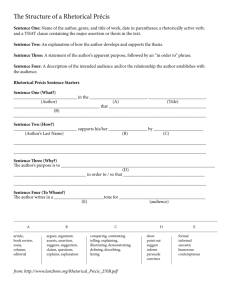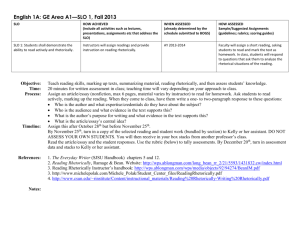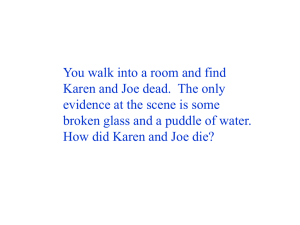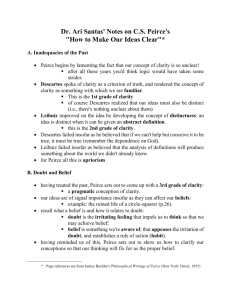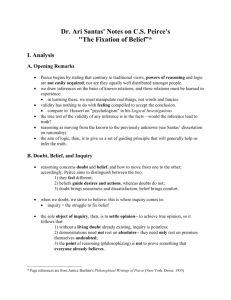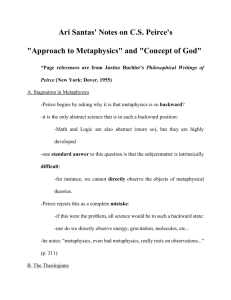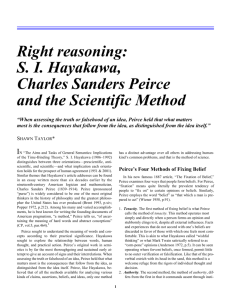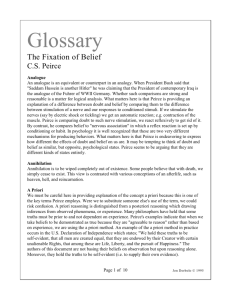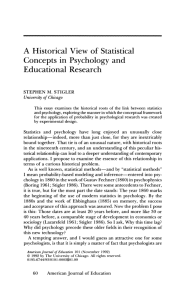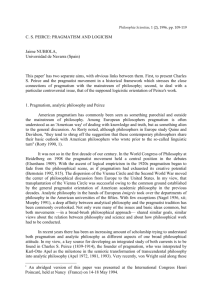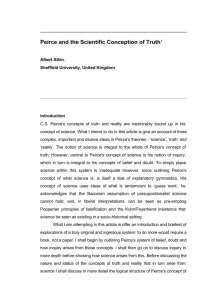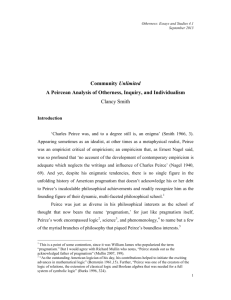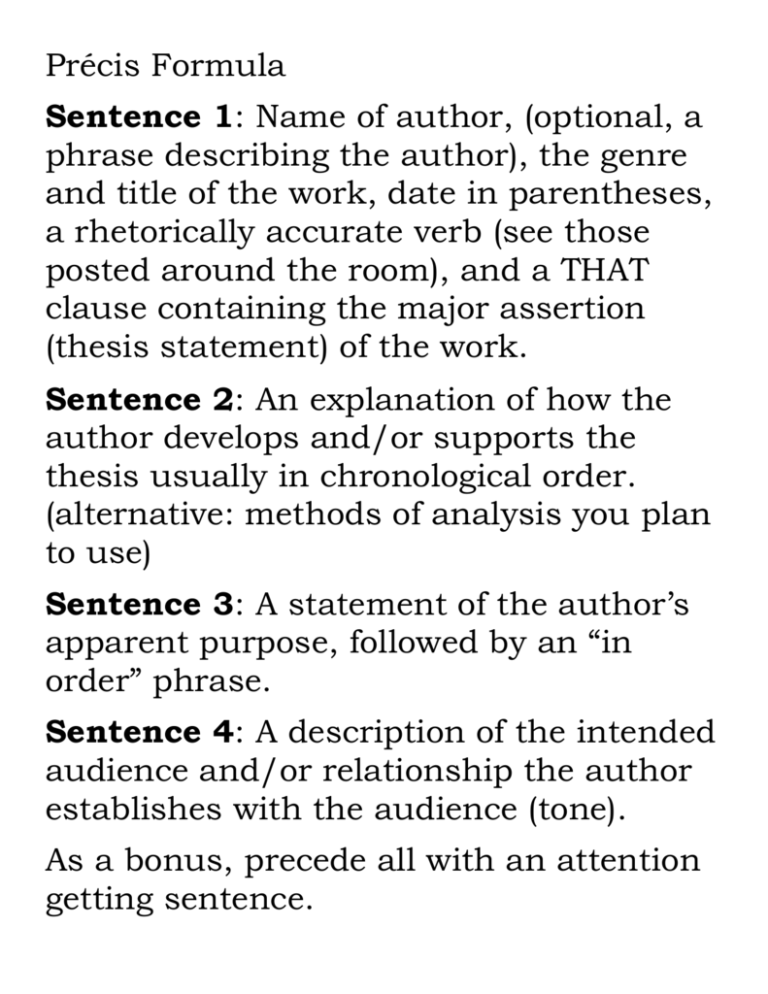
Précis Formula
Sentence 1: Name of author, (optional, a
phrase describing the author), the genre
and title of the work, date in parentheses,
a rhetorically accurate verb (see those
posted around the room), and a THAT
clause containing the major assertion
(thesis statement) of the work.
Sentence 2: An explanation of how the
author develops and/or supports the
thesis usually in chronological order.
(alternative: methods of analysis you plan
to use)
Sentence 3: A statement of the author’s
apparent purpose, followed by an “in
order” phrase.
Sentence 4: A description of the intended
audience and/or relationship the author
establishes with the audience (tone).
As a bonus, precede all with an attention
getting sentence.
YOUR Précis
________________________________, _____________________________
author
description of author
in his (or her)___________________________________ (____________)
genre and title
date of publication
_______________________ that __________________________________
rhetorically accurate verb
thesis or major assertion
______________________________________________________________.
____________________ _______________________by first ___________
author’s last name
develops or supports
various supports
____________________________, then ____________________________
various supports
__________________, and finally ________________________________
various supports
___________________________________. His or her purpose is to
_________________________________________________________ in
what the author does in the text
order to ____________________________________________ .
what the author wants the audience to do after reading the text
Choose one of these sentences:
He or she establishes a
________________ relationship
tone
with ______________________
intended audience
He or she establishes a
______________ tone for a
tone
_______________ audience.
intended audience
Don’t write on this sheet. Keep it as a reference to remind
yourself how to write the précis.
Rhetorically Accurate Verbs
(what to use instead of the to be verb)
evokes
uses (weak)
utilizes (weak)
elicits
manipulates
alludes to
twists
ignites
suggests
hints at
creates
depicts
conveys
conjures up
juxtaposes
portrays
differentiates
maintains
shows (weak)
implies
connotes
explains
elucidates
emphasizes
enunciates
clarifies
repudiates
refutes
tackles
compares
shifts
changes
evokes
invokes
delineates
alters
describes
enhances
paints
prone to
produces
reveals
ignites
asserts
stirs
inspires
explores
dispels
demonstrates
constrain
masters
construe
transcends
illuminates
solidifies
probes
details
informs
depicts
enlarges
mimics
Sentence 1 includes:
Name of author (possibly including a phrase that establishes his or her credentials)
Type of work and title
Date (in parentheses)
Rhetorically accurate verb that describes what the author is doing in the text
A THAT clause in which the major assertion or thesis is identified
Sentence 2 includes:
Explanation of how the author develops or supports the thesis ( compare/contrast,
narrative, illustration, definition, etc.)
Chronological order of the items of support presented by the author in the text
(or methods of analysis you intend to use)
Sentence 3 includes:
Statement of purpose
Followed by IN ORDER TO clause explaining what the author wants the audience
to do or feel as a result of reading the work
Sentence 4 includes
Description of the intended audience
Description of the tone
Here are some other examples of similar précis:
In her article "Who Cares if Johnny Can't Read?" (1997), Larissa MacFarquhar asserts that Americans are reading more than ever
despite claims to the contrary and that it is time to reconsider why we value reading so much, especially certain kinds of "high
culture" reading. MacFarquhar supports her claims about American reading habits with facts and statistics that compare past and
present reading practices, and she challenges common assumptions by raising questions about reading's instrisic value. Her purpose
is to dispel certain myths about reading in order to raise new and more important questions about the value of reading and other
media in our culture. She seems to have a young, hip, somewhat irreverent audience in mind because her tone is sarcastic, and she
suggests that the ideas she opposes are old-fashioned positions.
from Bean, John C., Virginia A. Chappell, and Alice M. Gillam. Reading Rhetorically, Brief Edition. New York: Pearson/Longman, 2004.
p. 63.
Toni Morrison, in her essay "Disturbing Nurses and the Kindness of Sharks," implies that racism in the United States has affected the
craft and process of American novelists. Morrison supports her implication by describing how Ernest Hemingway writes about black
characters in his novels and short stories. Her purpose is to make her readers aware of the cruel reality of racism underlying some of
the greatest works of American literature in order to help them examine the far-reaching effects racism has not only on those
discriminated against but also on those who discriminate. She establishes a formal and highly an analytical tone with her audience of
racially mixed (but probably mainly white), theoretically sophisticated readers and critical interpreters of American literature.
from http://www.wam.umd.edu/~sapinoso/precis.htm
Sandra M. Gilbert, professor of English at the University of California, Davis, in her essay “Plain Jane’s Progress” (1977), suggests
that Charlotte Brontë intended Jane Eyre to resemble John Bunyan’s Pilgrim’s Progress in that Jane’s pilgrimage through a series of
events based on the enclosure and escape motif eventually lead toward the equality that Brontë herself sought. Gilbert supports this
conclusion by using the structure of the novel to highlight the places Jane has been confined, the changes she undergoes during the
process of escape, and the individuals and experiences that lead to her maturation concluding that "this marriage of true minds at
Ferndean – this is the way" (501). Her purpose is to help readers see the role of women in Victorian England in order to help them
understand the uniqueness and daring of Brontë’s work. She establishes a formal relationship with her audience of literary scholars
interested in feminist criticism who are familiar with the work of Brontë, Bunyan, Lord Byron and others and are intrigued by
feminist theory as it relates to Victorian literature.
from http://www.winthrop.edu/english/core/success/precis.htm
Charles S. Peirce's article, "The Fixation of Belief" (1877), asserts that humans have psychological and social mechanisms designed to
protect and cement (or "fix") our beliefs. Peirce backs this claim up with descriptions of four methods of fixing belief, pointing out the
effectiveness and potential weaknesses of each method. Peirce's purpose is to point out the ways that people commonly establish their
belief systems in order to jolt the awareness of the reader into considering how their own belief system may the product of such
methods and to consider what Peirce calls "the method of science" as a progressive alternative to the other three. Given the technical
language used in the article, Peirce is writing to an well-educated audience with some knowledge of philosophy and history and a
willingness to other ways of thinking.
from http://oregonstate.edu/instruct/phl201/modules/rhetorical-precis/sample/peirce_sample_precis_click.html
Charles S. Peirce’s article, “The Fixation of Belief” (1877),
asserts that humans have psychological and social
mechanisms designed to protect and cement (or “fix”) our
beliefs. Peirce backs this claim up with descriptions of four
methods of fixing belief, pointing out the effectiveness and
potential weaknesses of each method. Peirce’s purpose is to
point out the ways that people commonly establish their
belief systems in order to jolt the awareness of the reader
into considering how their own belief system may be the
product of such methods and to consider what Peirce calls
“the method of science” as a progressive alternative to the
other three. Given the technical language used in the
article, Peirce is writing to a well-educated audience with
some knowledge of philosophy and history and a
willingness to other ways of thinking.
Charles S. Peirce’s article, “The Fixation of Belief” (1877),
asserts that humans have psychological and social
mechanisms designed to protect and cement (or “fix”) our
beliefs. Peirce backs this claim up with descriptions of four
methods of fixing belief, pointing out the effectiveness and
potential weaknesses of each method. Peirce’s purpose is to
point out the ways that people commonly establish their
belief systems in order to jolt the awareness of the reader
into considering how their own belief system may be the
product of such methods and to consider what Peirce calls
“the method of science” as a progressive alternative to the
other three. Given the technical language* used in the
article, Peirce is writing to a well-educated audience with
some knowledge of philosophy and history and a
willingness to other ways of thinking.
* Notice that the author explains why he believed the audience to be
well-educated.

